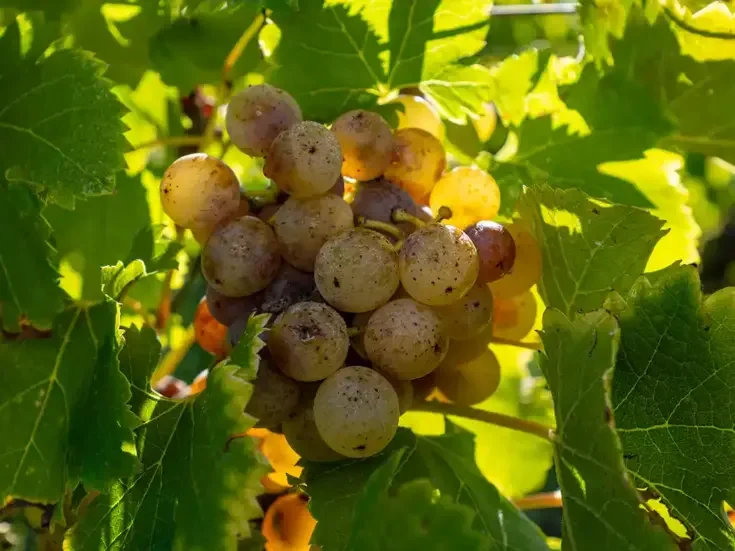
2023 Bordeaux tasting notes: Left Bank Part I
MÉDOC / HAUT-MÉDOC / MOULIS
Château Charmail (40% M, 35% CS, 25% CF)
SF | Dense purple. A lovely nose of plum skin, graphite, and the fresh breeze of the northern Gironde. Lifted raspberry fruit, a plush yet almost savory mouthfeel, and layered, chalky tannins support wave after wave of fruit. Plenty of matière and a very elegant finish. | 91–92
Château Potensac (48% CS, 35% M, 17% CF)
SF | Tasted amid a fanfare of exuberant Pomerol (the Delon family own both Potensac and Nénin), this property, a huge estate several kilometers to the north of St-Estèphe, offers a very pleasant surprise, its old-school, slightly drying tannin and robust tar-and-spice fruit character a welcome antidote to the plush of the Pomerolian Merlot. Among its peers, I suspect that the faint whiff of rusticity may be more evident, but for those of us who enjoy an occasional prelapsarian slug of luncheon claret, this is just the ticket. Jesting aside, there is real depth and complexity here and a pleasing lift on the finish, which is, obviously enough, uplifting. | 92–93
Château Poujeaux (55% CS, 35% M, 10% PV)
SF | Cabernet Sauvignon and Petit Verdot are back in charge this year, and it is hardly surprising that the wine’s beautifully scented cassis attack segues effortlessly into a firm, spicy finish, nourished by one third new oak. Very droit, says the owner Matthieu Cuvelier; very straight and serious, with impressive density and weight of tannin. It comes as a not totally disagreeable surprise to find out, therefore, that the alcohol level is a mere 12.5%. This impressive Moulis certainly does not lack for gravitas or seriousness of intent. | 92–93
Château Sociando-Mallet (50% M, 47% CS, 3% CF)
SF | François Hugueniot advises that the Gironde breezes were sufficient to ward off the mildew and that the late August heat was ideal for ripening his Cabernet Sauvignon, which is reliable and impressive at the back of the palate, enrobing a generous structure with confidence. Particularly striking is the quality of the Merlot, which plumps up the mid-palate, allows the 80% of new barrels to bed in, and facilitates a pleasing structure, with lively, lifted acidity and firm resolution. | 93–94
2023 Bordeaux Field Notes: Out of sorts?
GRAVES / PESSAC-LÉOGNAN BLANC
Château Carbonnieux Cru Classé (65% SB, 35% Sm)
SF | Eric Perrin has a lot of time for the great teachers Lurton and Dubourdieu—indeed, their philosophy can be evidenced in a reductive approach, in the control of yields, and in the veneration of old vines, all the way down to the use of the Bucher Inertys press and the Diam cork. He is less sure, however, when it comes to their preference for Sauvignon Blanc over Semillon. There is room for both, surely, he argues, and no need to be anxious, structurally, as the summers get warmer and warmer. QED with the 2023, where the 35% Semillon holds its own with ease, the flavors of nutmeg, quince, and almond all in its debt, the viscosity far from overbearing, the texture clean and elegant. Eric’s son Andréa learned a lot from Olivier Leflaive, but it appears he has mastered Semillon all on his own. The signature style of white Bordeaux is in very safe hands. | 93–94
Domaine de Chevalier Cru Classé (70% SB, 30% Sm)
SF | Unusually, this appears to be just as open, if not actually more so, than the Esprit, with plenty of orchard fruit and chalky complexity to seduce the suspecting taster. Roused, Somnus-like, it will in all likelihood opt for further slumber in the short term, girding itself for the long haul. Stone-fruit complexity here and a magnificent textural richness underscoring the fruit. The next dimension. If you respect the fruit, says Olivier, then the fruit will respect you. Maybe not his most poetic aphorism—and hardly a Faustian pact—but certainly true. | 96–97
Esprit de Chevalier (65% SB, 35% Sm)
SF | Fine white gravel on deep clay, with 7ha (17 acres) undergoing organic conversion. Pale, smoky, evocative, with delightful aromas of apple charlotte, hazelnut, and Viennese patisserie. Delicious, with a noble bitterness twisting itself around the finish. This has the spirit of a very noble Chevalier. | 93–94
Clos Floridène (50% Sm, 50% SB)
SF | A bedrock of limestone underwrites the lively style of this wine, each grape variety having its say (a sappy thrust is matched by a layered, almost waxy mid-palate), the relative altitude of the vineyard ensuring freshness and a clean, crisp finish. A very commendable Floridène. | 92–93
Château de Fieuzal Cru Classé (60% SB, 40% Sm)
SF | Stephen Carrier is a Champenois, and thus he knows all about the significance of fractional pressing, the fractions in this case dictated by relative pH level. Precision and purity ensue, freshness but with no compromise on either texture or aromatic, both informed by candle wax, lanolin, and fresh fruit. Acacia now trumps oak in terms of the barrel of choice, its thicker, less permeable, less influential lignin structure welcomed in the quest to maintain and exult a fundamental purity of fruit. The 12.5% ABV, these days seen as relatively low, ensures that the taster is neither distracted nor overwhelmed by a structural embrace. | 93–94
Château La Garde (91% SB, 9% Sm)
SF | This is an eloquent testament to limestone’s affinity with Sauvignon Blanc, expertly brought up in a combination of stainless steel, vat, and barrel, the later only 5% new, none of it therefore getting in the way of layers of agrume fruit, grapefruit to the fore, then quince and a hint of white tobacco. Bâtonnage took place every week until February. More opulent than many of its peers, perhaps, but still harnessed by the virtues offered by a low pH and a complex structure. | 92–93
Château Haut-Brion 1er Cru (58% SB, 42% Sm)
SF | Closed, deftly composed, serious, profound, and subtle. More layered and enigmatic than La Mission (as usual) and yet also maybe more grounded, the almond and hazelnut character adding cashmere gloss to the impressive core of fruit. The 46% new oak has been seasoned with discretion, and the alcohol is a far-from-domineering 13.8%. This should evolve gracefully and rewardingly. | 95–96
La Clarté de Haut Brion (56% SB, 44% Sm)
SF | The de facto second wine from both of the senior wines, for once without a majority of Semillon. Agrume and spearmint, hints of grapefruit and nougat, citric fruit very much in control, the lanolin subplot far from controversial; freshness maintained and respected. The pH is 3.2, the seam of acidity reassuring but not domineering. | 92–93
Château La Mission Haut-Brion Cru Classé (65% SB, 35% Sm)
SF | More open on the nose, as so often with La Mission Blanc, encyclopedic in its allusive dexterity. Almonds and nougat to the fore, then citric fruit, an ethereal scherzo, almost spritz-like—Titania in the forest, a magical, uplifting experience. Often the Semillon quota is double, so this is a departure, highly successful in its textural integrity, and with plenty of space to develop, the acidity neatly harnessed in support of all such ambition. | 95–96
Château Larrivet Haut-Brion (95% SB, 5% Sm)
SF | There were no mildew problems with the white wine, but the relatively parsimonious yields from the (old-vine) Semillon reduced its share of the final blend, which, certainly in at this early stage of development, marks out the striking acidity at the expense of a structural depth. No issues with the aromatic, which is delightful: wax, verbena, gorse, and even a whisper of coconut. The mid-palate is pretty rather than profound, however, and the finish lacks a little in definition. Nothing bittersweet here; it is rather abrupt and foursquare, the intimations of sucrosity banished for now in a miasma of sulk. A little more time to settle down is the prognosis. | 92–93
2023 Bordeaux Field notes: Single spies
Château Malartic Lagravière Cru Classé (80% SB, 20% Sm)
SF | A mere 7ha (17 acres) of white grapes provide the grapes for this, the grand vin, and also the Comte de Malartic, which tends to have a higher proportion of the younger Semillon included. The selection is more down to the pressing process than anything else, with both the first and last pressings eschewed and both Burgundian and Bordelais barrels employed, 50% of which are new. A highly attractive nose, a festival of lanolin, gorse, and white peach, then an elegant and generous mid-palate, weighty and yet light on its feet, typical, confident, and poised. The marked salinity on the finish dispels any bitter thoughts and ensures longevity. The vital signs are good. | 92–93
Château Pape Clément Cru Classé (60% SB, 35% Sm, 4% SG, 1% Mus)
SF | A deep gold, with attractive aromatics of honeydew melon and quince, white tobacco and tangerine. Matt Turner, maître de chai, felt, unlike many of his peers, that the Semillon did indeed have sufficient acidity and therefore, rather radically, he actually increased its voice in the blend. The rich texture and layers of fruit do not seem incontrovertibly to block freshness, and the delicious nougat hazelnut subplot both point some way toward vindication. The use of neutral vessels and ceramic eggs may well have assisted in maintaining a purity of voice and in avoiding the inference of too much of a good thing. | 93–94

Château Smith Haut Lafitte (90% SB, 5% SG, 5% Sm)
SF | The 20-year-old Sauvignon Gris is more textured, more viscous than its sibling, thereby providing a bridge to the Semillon and leavening the octave that potentially separates the two voices. All is harmony here, therefore, from the gentle floral nose, with its delicate notes of lime blossom and acacia, through to the palate, with its elegant, stone-fruit foundations and alluring, yellow fruit personality. Gentle phenolics tease the refreshing backbone of acidity and allow the wine to stretch itself a little, limbering up for a happy future. The flinty note on the finish almost recalls Chablis. | 94–95
Le Petit Smith Haut Lafitte (80% SB, 20% Sm)
SF | There is more Semillon in the Petit than in the Grand SHL; it is not central to the identity of the property (representing only 5% of the white grapes), though Fabien Teitgen does not rule out the possibility of planting more. It certainly works well here, adding a layer of citrus fruit and a clove texture to the Sauvignon, which is itself richly aromatic and allusive this vintage. | 92–93
Les Hauts de Smith Blanc (100% SB)
SF | The amphora experiment is over here for the foreseeable future—Fabien Teitgen was not sufficiently happy with the texture—so it’s back to wood, with a generous 50% of it new. All three of the white wines, indeed, enjoy the same treatment in this respect, only its length providing a degree of differentiation. Thus, this is a rich, layered Sauvignon but not lacking for gorse and lanolin aromas and a pleasing mid-palate lift. | 92–93
2023 Bordeaux Field notes: Château Lafleur—La Balançoire
GRAVES / PESSAC-LÉOGNAN ROUGE
Château Carbonnieux Cru Classé (55% CS, 33% M, 7% CF, 5% PV)
SF | Deep ruby red, with aromatics dominated by black tea, raspberry, and forest floor. Gentle and evocative, no evidence whatsoever of the 40% new oak. Silky, crisp, elegant; a hint of salinity at the back, sapidity at the very least. An old-school classic, carrying its 14% ABV with the greatest of ease, refined, pure, dignified. And drinkable… oh, so drinkable—almost at once, but best over the next decade. | 93–94
Château Les Carmes Haut-Brion Cru Classé (50% CF, 30% CS, 20% M)
SF | The Bouchet notches up 50% in 2022, old-vine rigor, small-berried intensity, and the legacy of an extraction that is as rigorous in application as it is delicate in enactment. A striking, imperious color, shouting freshness and drinkability, then an aromatic gamut that tilts toward the floral (violets and late-season roses), with blue and black fruit in support. Once again, the whole clusters have not only affected the pH (3.6), they have also refined the tannic foundation. More open than the 2022 at an equivalent phase, but just as refined, its magisterial potential writ large from the outset. | 96–97
C des Carmes (60% CS, 38% M, 2% PV)
SF | Dense purple, inviting. One senses the Atlantic breezes all the way here—from the fresh aromatic attack, to the sapidity on the finish. 25% whole-cluster fermentation allied to a rigorous sorting regime have bequeathed a forward, generous wine; bilberry and sloe, very fine, sylph-like tannins and a clean, reassuring finish. | 92–93
Domaine de Chevalier Cru Classé (65% CS, 25% M, 5% PV, 5% CF)
SF | Intense color, with a nose of tobacco, hearthside, blue fruit, then cassis, teeth-staining extract, charcuterie, and forest-floor spice. The tannins are sapid, uptight, almost (but not quite) green (100% destemming here). Olivier Bernard underlines the enigma; this big-boned, deeply saturated beast is the child of an apparently cool year, and yet the (relatively early) timing of its harvest is not inconsistent with a much warmer year. It is one of the most concentrated of the ’23s, and yet the handling at all times has been gentle and measured. One to watch as the enigma unravels… | 96–97
Esprit de Chevalier (65% CS, 30% M, 5% PV)
SF | Big color, near obsidian, but there is deep quality in play here rather than overextraction. The nose is lively and playful, with spice and dark fruit dominating the attack, cloves and pepper on finish. A rich, savory mouthfeel, perhaps at the moment a little too muscular (costeau); lantern-jawed—rather stentorian for this vintage. A little time should sort it out nicely. | 92–93
Clos Floridène (70% CS, 30% M)
SF | The limestone Cabernet has grip and a pleasing purity of dark fruit, with classic, authoritative, gravelly tannins and a bright line of acidity. Relatively low alcohol (13% is relatively low these days), from a year that Jean-Jacques Dubourdieu describes as “temperate,” completes a very satisfactory tableau. | 93–94
Château de Fieuzal Cru Classé (50% M, 40% CS, 10% PV)
SF | Stephen Carrier advises that the Merlot provides the “direction,” winning with its plush veneer and, in this case, refined blue-fruit attack, thereafter handing over control to the Cabernet Sauvignon and the Petit Verdot, which ensure longevity and the endorsement of tannic potential, nothing overworked and all in keeping with the forward, elegant personality of the vintage. The influence of consultant Thomas Duclos is evident, and yet a distinct Fieuzal style is emerging: less abrupt, less aspirational, altogether more honest and forgiving. To prove his point and with characteristic generosity, Stephen opens bottles from 2019 (I have suggested, incorrectly as it turns out, that ’23 will be like ’19), from 2018, and from 2016. All more weighty, denser, more challenging, and maybe more challenged. The 2023 bears the imprimatur of a winemaker at ease, coaxing complexity and a winning freshness from a pleasant vintage. He calls it, summoning up his inner FDR, his “New Deal.” | 93–94
2023 Bordeaux Field notes: The endless appeal of Sauternes
Château La Garde (57% CS, 43% M)
SF | The shift to Cabernet Sauvignon continues apace, the gentle gravel slopes behind Martillac well suited to show off the full potential here, its progress perhaps slowed by the fact that it does not, for mainly historical reasons, enjoy cru classé status. The investment by Dourthe and the vision of consultant Axel Marchal are starting to impress, however. The volume of the senior wine has been reduced by half, and assemblage now takes place before aging. The 2023 is plush and forward (both adjectives work for the white wine, too) but does not stray toward indulgence, the harmonious grip of tannin and acidity seeing to that and ensuring that the fruit, ripe though it is, does not get the better of aspiration. With its August tris for the white and mid-October picking for the last of the reds, La Garde rehearses in miniature the seasonal dance, which is patient, measured, and dignified. | 91–92
Château Haut-Bailly Cru Classé (58% CS, 34% M, 4% PV, 4% CF)
SF | Extraction techniques used to tame the Petit Verdot (supremely gentle techniques, in other words) are now used for all grape varieties. The resulting tannic structure is powdery, elegant, and silky; nothing aggressive, green, or astringent. The 54 small tanks in the new chai have been put to good use, to ensure that the assemblage respects the minutiae of this, at times far-from-straightforward, vintage. The result is excellent—more cerebral than its sibling, for sure, but sharing an approachability unthinkable in the Bordeaux of even five years ago, yet all the while disinclined to forsake a capacity to age gracefully. | 95–96
Haut Bailly II (64% M, 34% CS, 2% CF)
SF | A friendly purple hue and equally friendly aromatics of crushed raspberry, mulberry, and cigar box; Merlot in its pomp, in other words, and interestingly, for the first time, including Merlot from the (now discontinued) Château Le Pape purchase, which, up to 2021 had been bottled separately. Nothing is jammy or overblown in the 14.5% ABV; the kiss of oak (30% new) is just that. A warm sensual experience, approachable yet not lacking for tension and depth—a significant achievement in itself. | 93–94
Château Haut-Brion 1er Cru (52% M, 39% CS, 9% CF)
SF | Benchmark Haut-Brion, broad, composed dignified, complex, and hitherto mysterious; notes of peat, sous-bois, and iodine, then tobacco and a generous fruity mid-palate, balanced acidity, and a strong, composed finish. The 75% new wood has been effortlessly integrated. Limbering up for greatness, its credentials already indented, but more—much more—still to come. The least demonstrative of the first growths at this early stage, as is often the case. | 96–97
Le Clarence de Haut-Brion (55% M, 41% CS, 4% CF)
SF | The Merlot is far more demonstrative than in the Chapelle, with a fruit basket of red and black fruit to choose from. Firm acidity supports a rounded, plush mid-palate and generous chalky tannins. More accessible than the Chapelle and, on the day, the most expressive of the quartet. | 92–93
Château La Mission Haut-Brion Cru Classé (53% M, 30% CS, 17% CF)
SF | A plot of Cabernet Franc usually destined for La Chapelle has emigrated to the senior wine, such is its quality, adding layers of leafy tisane complexity to the bedrock of powerful fruit. Bay leaf and black pepper in support. The pedigree is not forsaken, however, with the elegance of tannins typically assertive, yet not lacking for elegance. A finely tapered finish, uplifting and yet profound at the same time, adds further nuance to the ensemble. Precision and power are harnessed with great expertise. | 94–95
La Chapelle de la Mission Haut-Brion (49% M, 39% CS, 12% CF)
SF | More austere than expected, with a leafy linearity that needs time. A firm shard of acidity and neat oak foundations (21% new) in support. Opens out gradually in the glass; a dignified slow burn, with resolution on the finish. | 91–92
Château Larrivet Haut-Brion (75% CS, 20% CF, 5% M)
SF | Bright, deeply pigmented, with an immediate floral elegance, with blue fruit, soft spice, and even a touch of chalk underwriting the tannic structure. The mid-palate holds the focus and builds the tension; then impressive but not overbearing grip on the finish. Very approachable, even though the Merlot (as in 2021 and this time directly as a result of the mildew) has been pushed back toward exile. A succulent, attractive style, far from potent at 13.3% ABV but lifted deftly at the end. In a minor, contemplative key and very worthy for a house that is, as the French might say, happy in its skin—not overreaching itself but fully aware of the potential of this specific terroir, where gravel and limestone are far more significant than clay. | 94–95
Château Malartic Lagravière Cru Classé (53% CS, 42% M, 4% PV, 1% CF)
SF | Deep color. A Cabernet nose of gravel, cassis, and ripe plum, the Petit Verdot adding spice and camphor to the finish, its 4% significantly higher than for its ’22’s debut, when it only notched up 1.5%. The 60% new oak is discreet but adds ballast and a backdrop for the darker varieties. Jean-Jacques Bonnie cleaves to the philosophy of sustainable farming (sheep and geese are on the payroll, to mow the cover crops, and they can sometimes be espied behind the tasting room by way of evidence). And the wines, repaying the compliment, are pure and undemonstrative but ultimately deeply satisfying. | 93–94
2023 Bordeaux Field notes: La Tour Figeac—La Chartreuse de St-Emilion
Château Pape Clément Cru Classé (50% M, 45% CS, 3% CF, 2% PV)
SF | The introduction of young-vine Cabernet Franc, allied to the reduction in maceration time, the focus on indigenous yeast, and, needless to say, an eye of passing fashion are all key to the construction here, not without Michel Rolland-induced power and oaky resonance, for sure, but certainly more elegant than of old, its aging now less reliant on the new wood or, for that matter, the 225-liter format. There is tobacco and licorice, a syrupy generosity, and a feel of hothouse plants, therefore something resembling the Pape Clement signature, but there is also a lighter touch to the tannins and an almost ethereal lift to the aromatic —all very encouraging. Still gourmand, yes, but perhaps a little less assertively so and therefore more in keeping with today’s marketplace. | 93–94
Château Rahoul (43% M, 45% CS, 12% PV)
SF | Dense purple color. A hint of reduction on the nose, redeemed by elegant, billowing fruit on the palate, black and red, subtle but controlling acidity and chalky tannins that guide the ensemble to a fluent peroration. 10% new oak. | 90–91
Château Smith Haut Lafitte Cru Classé (70% CS, 23% M, 1% PV, 6% CF)
SF | The Cabernets dominate this year, very much in accordance with the “temperament” of the vintage, according to cellar master Fabien Teitgen. There is more Cabernet Sauvignon than usual, and the Franc, if only 6% of the blend, is disproportionately articulate, lending a herbal sprig to the blackcurrant bush. With agitation, further complexity is unleashed: licorice, eucalypt, and clove, to name but three. Pencil lead and woodsmoke betray the 60% new oak, the texture suitably robust and yet with a velvety reassurance born of excellent husbandry. Fabien is at the top of his game, and this property, sometimes underappreciated (often for reasons that have little to do with the product), is now really singing. King Charles III chose it for his one vineyard visit when in Bordeaux this spring—an excellent choice, if I may presume. | 95–96
Les Hauts de Smith (60% M, 40% CS)
SF | The sommelier’s favorite, I am told, and it is easy to see why. Enrobed in bright ruby, with fleshy Merlot-dominated aromatics, this is forward and harmonious, wearing its 30% new oak lightly, with a tight, persuasive finish. | 92–93
Le Petit Smith Haut Lafitte (60% CS, 40% M)
SF | The proportions of the grape varieties are inverted here (in relation to Les Hauts), with Cabernet now very much in control; dark, brooding, gravelly, with grip and authority. The balustrade of tannins is finely wrought, and the acidity is cleanly focused. | 92–93
2023 Bordeaux Field notes: House of cards







